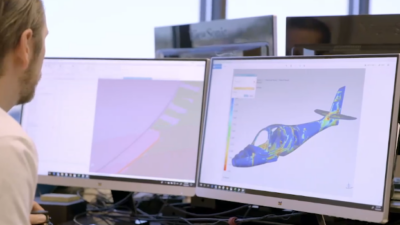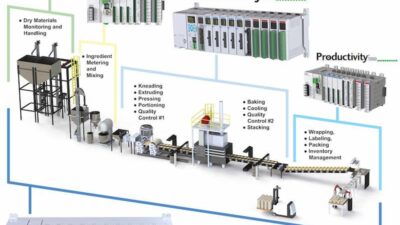Increased interest in smart plant technologies and intelligent plant implementations are among topics in this Control Engineering China discussion with Jiang Yachun, senior technology expert of Honeywell Process (China).

In the United States, Europe, and Japan, the establishment of intelligent plants is among the mid- and long-term goals for manufacturers. Plant intellectualization also is an important target of the transformation and upgrading of the domestic manufacturing industry and has been widely accepted by business and academic circles and governments. No specific or uniform standards have been established for determining what constitutes an intelligent plant or a smart plant. Personal understandings differ.
Industrial enterprises may actively promote the establishment of intelligent plants as a means to achieve greater competitiveness, while solution suppliers have different interpretations based on their own demands or approaches to achieve specific objectives.
What is an intelligent plant?
While there is no consensus on "intelligent plant" details, common elements are emerging among those using the term. The Smart Process Manufacturing Foundation, an international organization concerned with the "intelligent plant" topic, said the conceptual structure of an "intelligent plant" is multidimensional and includes project delivery, application integration, and engineering collaboration with the enterprise resource planning (ERP) system-supported by operations, maintenance, and decision-making; and client or supervised remote browsing portal, document management, and control. The purpose of all these solutions is to help clients, contractors, and suppliers simplify the process of cooperative work in the environment of information sharing, and enhance the quality and efficiency of the workflow of the whole value chain in and out of an enterprise.
Jiang Yachun, senior technology expert of Honeywell Process (China), has also paid attention to the discourse of international organizations on the topic of "intelligent plant."
He told Control Engineering China: "I think the general orientation of the concept of ‘intelligent plant’ made by the Smart Process Manufacturing Foundation is correct, although it is still hard to execute this concept."
The reason why Jiang agrees with this concept is that it adopts the general trend in IT development today-cloud computing. That is, each of the large-scale manufacturing enterprises shall build a platform, similar to that of Google’s Android or Apple’s App Store, in the cloud. All clients, suppliers, or partners related to this large-scale enterprise can build applications based on the platform.
Does that mean "intelligent plant" is the exclusive product of large-scale manufacturing enterprises with the capacity of constructing large-scale information and automation platform?
Jiang said: "Yes, the ultra-large industrial enterprises are the core promoters of intelligent plants, and they can build integrated smart platforms that conform to their requirements for integration and coordination, knowledge management, and performance management. Small- and medium-sized enterprises shall upgrade and transform technologies for suppliers and supporters on the outer value chain, based on the platforms and rules that large-scale enterprises have established."
Based on Jiang’s views, small- and medium-sized manufacturing enterprises’ interest in the "intelligent plant" concept seems likely to increase. There is some controversy that with an "intelligent plant," when the automation of a plant reaches a certain level, the plant may operate with fewer people and more intelligent machinery, equipment, and production systems. More efficient, optimized, and flexible production can be achieved through the combination of smarter use of information and automation. This may not necessarily be directly related to the cloud computing stressed by Jiang Yachun. Managing several plants can be enabled with a cloud computing platform, but, strictly speaking, does an intelligent plant equate to a cloud-computing platform? Can it be an intelligent plant without the integration of supply chains?
Flexible, scalable
"’Intelligent plant’ is a term meant for an entity, and, for a plant, such description is true," Jiang said, "But it cannot be static, fragmented, or inextensible. For a group, it must have upstream and downstream industries and supply chains. The greatest challenge a plant faces is the problem of upstream and downstream supply chains, which includes the supply chain of energy. The process of an intelligent plant can only be sorted when the problem of the supply chain is solved. The same may not be said otherwise. The numerous peripheral supporting enterprises and service enterprises of the value chain cannot be mentioned in the same breath," Jiang said, with large enterprises working on intelligent plants.
Intelligent plant difficulty?
In Jiang’s view, in addition to having intelligent manufacturing software and hardware, a plant should also integrate the systems of all plants, and introduce a supply chain that complements the "rhythm" of its intellectualization. All this is essential and must be adopted by the entire group and receive top-level design. If the top-level design isn’t set, it should be carefully implemented.
Is it too difficult to implement intelligent plants, or is the current discussion immature? Or is the goal of intelligent plants not clear enough, with too many variants and risks? Could it be that "intelligent plant" is only speculative in the industrial market?
Jiang said: "It cannot be regarded as speculation, but the practice of intelligent plants is really difficult. The difficulty is not in the collaboration with peripheral suppliers, but in the establishment of smart platforms of large and ultra-large groups that are in the core of the value chain. It can be compared to the development and application based on Apple’s iOS platform or Google’s Android platform of Google. A lot of people can develop, but the platforms have been established based on the… large investment by Apple Inc. and Google Inc. Only a few groups with similar strength can establish such platforms."
Jiang continued, "There are a few benefits in discussing ‘intelligent plant.’ If some concepts are promoted, or people in some industries are encouraged to increase investments, some beneficial improvements may be achieved in technology for plants."
Jiang thinks that promoting smart plants can increase capacity in the short term, though there is still a long way to go. He hasn’t found a plant yet that has achieved such an integrated overall structure.
First step, long march toward intelligent plant
Intelligent plant challenges are many; what should be the first steps?
Jiang advised starting with the most pressing industrial upgrades. Do demands vary by industry? In the petroleum and petrochemical industries, for example, Jiang said that visible collaboration is a pressing demand, especially for general dispatch or production departments.
"The problem that they want to solve is visualization. Previously, there were large screens for display, but information from seven or eight systems needed to be displayed, so the operator had to switch among all display interfaces to find the information, which was very inconvenient. Many information systems were built, but when they were finished, operators in the control room realized that the information" was difficult to find and discern.
Intuition executive
The first characteristic of an intelligent plant is visualization, but it is only having "large screens." Real-time information is the emphasis. People from different functional departments need different information. Indices and information that production managers and operators need aren’t necessarily improved by having more data. Visualization lets different people see accurate information they need through a unified interface. When different departments want to communicate, they can do so directly on a unified platform. Visualization is conducive to finding problems in a timely manner. During the problem solving process, the actual execution of the workflow needs to be collaborated on, communicated, and the conclusion made, and a progress report tracing the process must be made available. Collaboration is likely to involve several departments and even external consultants. The advantage of a collaborative platform is that people can work on this unified online platform instead of an off-line platform.
According to Jiang, an intelligent plant shall at least have such a unified and visual collaboration platform.
Honeywell Intuition Executive (IX), the company’s next generation of collaborative visualization software, focuses on solving the problems of visualization and collaboration.
This software and the latest Alarm Management System can support visualization and collaboration on tablets and mobile phones. Originally, the alarm information could only be seen by the operator of central control room and with a small audience. Now, more people can see the information using the mobile network, which helps to achieve collaboration between people on the scene and the control center, and even among people from other departments. Mobile networks are a clear attribute of intelligent plant development.
Intuition Operations Monitoring software
Because each industry’s engineering needs differ, enterprises cannot expect to have a standard intelligent plant. Intelligence must serve the demands of each individual enterprise.
"At present, there is not a unified standard design for intelligent plants," Jiang said, "but corporations are encouraged to design a unified infrastructure at the top level when building an intelligent plant. For example, the IX of Honeywell and other applications of Intuition (including the operation monitor IOM, operation log IOL, Alarm Management, etc.) are built on the unified Intuition Platform," which can support mobile devices, workflow management, unification of data-acquisition interfaces, and semantic models. If an enterprise wants to builds an intelligent plant, the project must include industrial characteristics, and customize them for the plant’s characteristics. "It is infeasible to simply copy other projects," Jiang said.
Another major attribute of an intelligent plant is knowledge preservation and sharing. When experienced operators retire and new ones take over, how can the experience and knowledge be passed on to the new operators?
The new Honeywell Alarm Management Database can explain the value and significance of various alarms. For example, what is the cause of an alarm? What will the consequence be if the alarm is ignored? What should the response be? Experienced operators have this information.
Top-level design, infrastructure
Jiang noted, from the micro perspective, no matter how advanced an alarm management system is, it is only a system tool; the optimal application depends on standards for its use from the enterprise and personnel. From the macro perspective, the building of an intelligent plant presents the same problem.
"What’s the measure of an intelligent plant?" Jiang asked. Is it persons in charge of the new architecture, hardware investments, or abilities of plant personnel?
Implementation isn’t easy and should be taken in steps. In an intelligent plant, whether for predictive maintenance or a product upgrade, work should begin with the inspection of instruments, Jiang said. There should be sufficient capacity for data flow, perception, and understanding so the investments will not be in vain.
The project architect, Jiang said, should be a senior person, as senior as a vice president. The individual should have architecture responsibilities, without personnel management involvement, and extensive experience and authority. A background in IT with familiarity of the industry and its applications is also needed, along with planning and design for the architecture of hardware, software, and processes.
Industrial enterprises outside of China often have such a position, but Jiang said he hadn’t seen one yet in China.
Information integration
Jiang said, "Indeed, the overall architect can effectively solve many problems from top to bottom. However, if there are too many outstanding problems of technical details at the production layer, the project of building an intelligent plant cannot be achieved. The data at the top level should go down, but the data below also needs to go upward, so the sources of data collection at the source should be built gradually. When the river rises, the boat floats high."
Overall hardware condition and personnel quality of an enterprise constitute the only realistic basis to gradually approach the concept of an intelligent plant, he said.
Planning and process
The goal of building an intelligent plant is grand and involves intellectualization preceded by the automation of equipment and production lines and the complex changes of reasonable and efficient allocation of production resources as the market allows. Meanwhile, a rapid-response status of the supply chain must be created around the central enterprise. It is very difficult for a large-scale enterprise to drive so many changes, which can almost be regarded as a revolution.
In addition to the technical revolution of adopting numerous new techniques, another difficulty is the challenge to innovate traditional processes and management models. Entrepreneurs may feel that they face greater pressure when seeking major changes in management than in technological innovation, and the challenges are far greater and more complicated.
Jiang suggested that, at the end of the day, we may never find a standard for intelligent plants. Since every industry has its own priorities and specific needs, the final realization of an intelligent plant might come in different forms and shapes.
Leap forward in 1958
As an engineer, Jiang seems to appreciate a realistic approach. Instead of dreaming about the grand future, enterprises should take smaller steps and focus on telling suppliers the problem they want to solve, discussing the budget, and asking about available technologies and best practices. This pragmatic approach allows an enterprise to continue making progress.
Jiang said, "On the contrary, if you have a grand goal and are anxious to achieve it overnight, you may easily make the same mistake as the ‘Great Leap Forward’ of China in 1958. Intelligent plants cannot be built in one day, especially given that the overall technical level of the domestic industry is not so high." The point about the overall technical level of industry in China emphasizes that "development should be pragmatic."
In Jiang’s view, there are still many risks in implementing the intelligent-plant project, because the theories for guidance are still at the experimental stage and immature. Considering that this is a complicated project that combines technology and management, the implementation may go wrong or not achieve the planned goal. Risks exist.
Whatever the result is, large-scale domestic industrial enterprises with great ambition are forging ahead in this direction by actively researching and assessing how to realize the prospective goal of building intelligent plants. Jiang said Honeywell provides consultation services in this area.
– Andy Zhu Xu (Zhu Xu) is editor-in-chief of Control Engineering China. Edited by Mark T. Hoske, content manager, CFE Media, Control Engineering, [email protected].
ONLINE
www.controleng.com/archives September has more information from Jiang and a link to a related article and video: "Changing the face of process control for a new generation."
Key concepts
- Plant intelligence can help improve decision-making and efficiency throughout the value chain.
- Implementing smart plant technologies can be difficult and can preserve intellectual knowledge as workers retire.
- A vice president involved with technology rather than personnel can help with project implementation.
Consider this
If plants in China are considering plant intelligence, greater efficiency, and supply chain visibility, shouldn’t yours?
ONLINE extra
A Honeywell white paper describes Honeywell Intuition Monitoring (IOM) software.
See related links from Control Engineering below.


